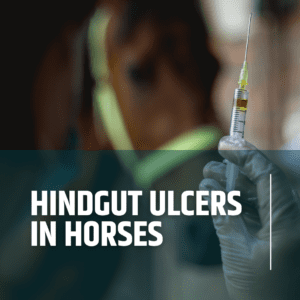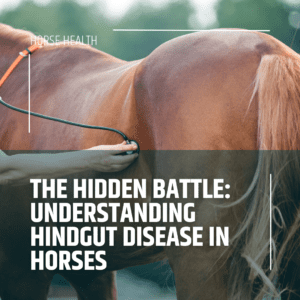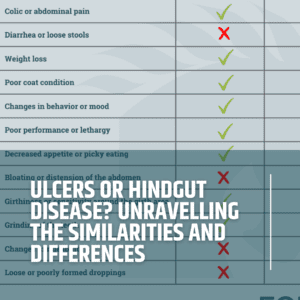
Ben Nedas
Chief Commercial Officer
Nutritional Support for Horses Being Treated for Ulcers

Effective ulcer treatment extends beyond pharmaceutical intervention. While medications such as omeprazole, misoprostol, and sucralfate are essential for healing gastric tissue, they significantly alter gastrointestinal physiology. Understanding these changes allows for strategic nutritional modifications that enhance treatment outcomes and minimise adverse effects.
Understanding Medication Effects on Digestion
Proton Pump Inhibitors (Omeprazole)
Omeprazole, the most commonly prescribed ulcer medication, blocks acid production by inhibiting the H+/K+-ATPase enzyme (the acid pump) in gastric parietal cells. This mechanism raises gastric pH from below 2 to approximately 3.5-4.5 for up to 14 hours.
Key physiological changes:
- Reduced calcium absorption: Studies demonstrate a 15-20% decrease in calcium digestibility due to decreased solubility of calcium carbonate at higher pH levels¹
- Impaired protein digestion: Pepsin, the primary proteolytic enzyme in the stomach, requires pH below 3 for optimal activity
- Potential for rebound acid hypersecretion upon discontinuation⁵
Misoprostol
This synthetic prostaglandin E1 analogue increases mucus and bicarbonate production while enhancing gastrointestinal motility. Treatment typically spans 14-30 days for glandular ulcers⁶.
Nutritional considerations:
- Increased intestinal motility may lead to looser faecal consistency
- Transient appetite suppression in some horses
- Enhanced gastric emptying rate affecting nutrient absorption timing
Sucralfate
Sucralfate forms a protective gel coating over ulcerated tissue at pH below 4. While effective as an adjunct therapy, it can bind dietary phosphorus and certain trace minerals.
Potential interactions:
- Phosphate binding may lead to hypophosphatemia (abnormally low blood phosphorus levels) with extended use⁸
- Chelation (binding) of trace minerals and certain medications
- Reduced bioavailability of tetracyclines and fluoroquinolones
Evidence-Based Nutritional Strategies
Calcium Supplementation
To compensate for reduced calcium absorption during omeprazole therapy:
- Select appropriate calcium sources: Marine-derived calcium and calcium lactate maintain better solubility at elevated pH compared to calcium carbonate
- Adjust total dietary calcium: Target 0.4% calcium on a dry matter basis
- Monitor calcium:phosphorus ratio: Maintain between 1.5:1 and 2:1
Enzyme Supplementation
Research indicates that supplemental enzymes can partially compensate for reduced pepsin activity. EquiNectar¹¹, a concentrated barley-malt extract, provides three key enzymes that address specific digestive challenges during ulcer treatment:
- Protease: The barley-derived protease in EquiNectar maintains approximately 40% activity at pH 4, compared to less than 10% for pepsin². This enzyme effectively compensates for reduced protein digestion when gastric pH is elevated by omeprazole therapy
- Phytase: Operating optimally at pH 4.0-5.0, this enzyme hydrolyzes phytic acid (a plant compound that binds minerals), releasing bound calcium and phosphorus. Studies show phytase supplementation can recover up to 50% of calcium lost to pH-related insolubility during PPI treatment⁴
- Fructanase: With peak activity at pH 3.5-6.0, this enzyme breaks down pasture fructans (complex sugars in grass) before they reach the hindgut. Research demonstrates 30% faster fructan degradation at pH 4 compared to pH 2, with malt extract supplementation doubling this rate³
The synergistic relationship between omeprazole and EquiNectar is particularly noteworthy: omeprazole creates the exact pH range (3.5-5.0) where these barley enzymes achieve optimal activity, effectively replacing the digestive functions compromised by acid suppression.
Feeding Management Protocols
Optimal dosing schedule:
- Administer omeprazole on an empty stomach
- Wait 30-60 minutes before feeding
- Include enzyme supplements with the first meal
Dietary composition guidelines:
- Limit starch and water-soluble carbohydrates to less than 1g per kg body weight per meal
- Provide continuous access to low non-structural carbohydrate forage
- Divide concentrates into multiple small meals (minimum 3 per day)
Post-Treatment Considerations
The cessation of proton pump inhibitor therapy requires careful management:
- Gradual withdrawal: Consider tapering dose over 3-5 days when possible
- Increased buffering: Provide additional calcium carbonate during the first week post-treatment
- Enhanced forage access: Ensure 24-hour access to appropriate forage to maximise salivary buffering
Monitoring Treatment Success
Most equine squamous gastric disease resolves within 21-28 days of appropriate therapy. Continuing medication beyond necessary duration increases risk of:
- Altered bone metabolism
- Disrupted hindgut microbiome
- Increased treatment costs
Follow-up gastroscopy remains the gold standard for confirming healing and guiding treatment duration.
Clinical Recommendations
- Work with veterinary professionals: Develop individualised treatment protocols based on ulcer severity and location
- Regular reassessment: Schedule follow-up examinations to evaluate healing progress
- Comprehensive approach: Address underlying management factors contributing to ulcer development
- Nutritional support: Implement dietary modifications concurrent with pharmaceutical therapy
Conclusion
Successful ulcer treatment requires integration of pharmaceutical therapy with appropriate nutritional support. Understanding how medications alter gastrointestinal physiology enables targeted dietary interventions that optimise healing while minimising adverse effects. By implementing evidence-based feeding strategies, practitioners can improve treatment outcomes and reduce the likelihood of ulcer recurrence.
For additional guidance on implementing these nutritional strategies, consult with your veterinarian or equine nutritionist.
References
- Archer, D. et al. Omeprazole Reduces Calcium Digestibility in Thoroughbred Horses. J. Anim. Physiol. Anim. Nutr. (2020). Available at: pubmed.ncbi.nlm.nih.gov
- Strauch, S. et al. In-vitro Effect of Gastric pH on Protein and Fructan Degradation. JPN (2017).
- Strauch, S. et al. ibid.
- Lang, J. et al. Apparent Digestibility of Phytate Phosphorus in Mature Horses. (2004). Available at: pubmed.ncbi.nlm.nih.gov
- Foster, G. et al. Evaluation of 57-Day Omeprazole Administration. Equine Vet. J. (2023). Available at: pmc.ncbi.nlm.nih.gov
- Borgia, L. et al. Pharmacokinetics of Misoprostol in Horses. AJVR (2023). Available at: avmajournals.avma.org
- Mad Barn. Misoprostol for Horses – Uses & Risks. (2022). Available at: madbarn.com
- Mad Barn. Sucralfate for Horses – How it Works. (2022). Available at: madbarn.com
- ScienceDirect Topics. 4-Phytase Overview. (Accessed 2025). Available at: sciencedirect.com
- BEVA. Should Omeprazole Be Withheld Before Competition? EVJ (2024). Available at: beva.onlinelibrary.wiley.com
- EquiNectar. What's in It? (2024). Available at: equinectar.com
ABOUT EQUINECTAR
Description
EquiNectar® is a natural feed supplement, that is scientifically proven to:
- Re-balance your horse’s gut bacteria
- Help your horse maximise benefits from its feed
- Improve your horse’s condition
More information
EquiNectar® is produced by Tharos Ltd in the UK. It is a natural source of digestive enzymes and contains only the following ingredients:
- Our patented enzyme rich malt extract
- Medium chain triglycerides (from coconut oil)
- Potassium sorbate
For more details of the enzymes within EquiNectar® take a look at the ingredients and enzymes page.
How to feed
Simply add EquiNectar® to your horse's daily feed, using the Feeding Rate chart to determine the correct amount.
For detailed instructions about how to introduce EquiNectar, please read the comprehensive Feeding Guide page.





